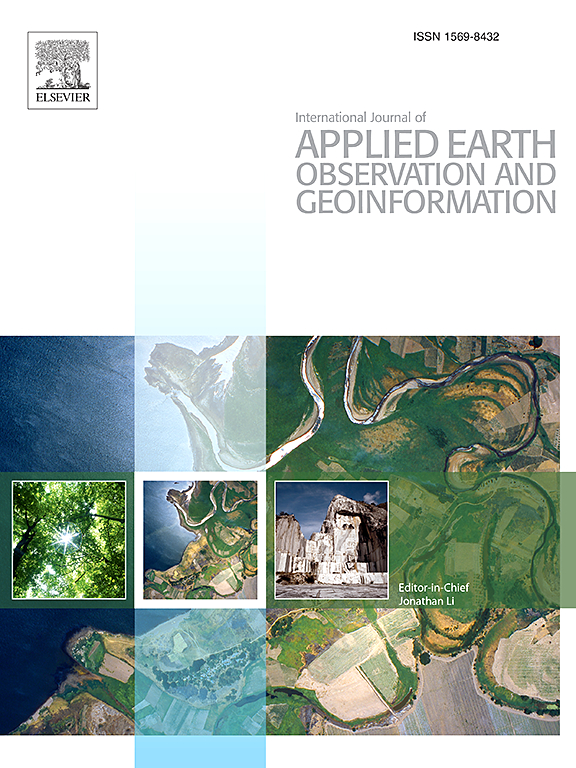利用移动设备收集的数据,对市民观察到的静态事件进行远程定位
IF 7.6
Q1 REMOTE SENSING
International journal of applied earth observation and geoinformation : ITC journal
Pub Date : 2024-12-01
DOI:10.1016/j.jag.2024.104287
引用次数: 0
摘要
智能手机的日益普及导致了众包活动的激增,市民可以利用先进的传感器轻松收集和上传信息,利用人群的集体努力。然而,这些设备在某些应用中有效使用之前必须解决精度问题。虽然大多数研究都集中在基于gnss的定位误差上,但基于罗经的定位误差却很少受到关注。本文提出了一种确定静态事件的地理位置的新方法,该方法通过组合位于目标事件周围的多个志愿者的贡献。该方法不使用直线,而是使用漏斗形区域来表示朝向目标位置的方位角,并包含不同的相位来解决由测量方位角引起的误差。与基于gnss的定位误差相比,这些基于罗经的定位误差受到的关注较少。该方法减轻了方位角测量中的不确定性,产生了一组包含不同置信度的目标位置的区域。在三个已知目标位置的案例研究中,使用面积和紧凑度等指标测试了其可靠性。结果是有希望的,表明开发的方法在不需要高度准确性的应用中特别有用(在许多众包项目中很常见),例如森林火灾的地理位置-一旦在附近就可以很容易地发现它们。在一个收集公民捐款的系统内实施这一做法,可以为当局提供宝贵的信息,使其能够在紧急情况下迅速采取行动。本文章由计算机程序翻译,如有差异,请以英文原文为准。
Remotely geolocating static events observed by citizens using data collected by mobile devices
The increasing use of smartphones has led to a surge in crowdsourcing initiatives, where citizens easily collect and upload information using advanced sensors, leveraging the collective efforts of the crowd. However, these devices face accuracy issues that must be addressed before they can be used effectively in certain applications. While most research has focused on GNSS-based positioning errors, compass-based orientation errors have received far less attention. This paper presents a novel method for determining the geolocation of static events by combining contributions from multiple volunteers located around a target event. Instead of straight lines, the method applies funnel-shaped regions to represent the azimuths toward the target location and encompasses various phases to address errors stemming from measured azimuths. These compass-based orientation errors have attracted less attention compared to GNSS-based positioning errors. The approach mitigates the uncertainty in azimuth measurements, producing a set of regions that contain the target location with different levels of confidence. Its reliability was tested in three case studies with known target locations, using metrics such as area and compactness. The results were promising, indicating that the developed approach is particularly useful in applications that do not require a high degree of accuracy (common in many crowdsourcing projects), such as the geolocation of forest fire ignitions − once in the vicinity they can be easily spotted. Implementing this approach within a system that collates citizens’ contributions can furnish invaluable information to authorities, empowering prompt action during emergency scenarios.
求助全文
通过发布文献求助,成功后即可免费获取论文全文。
去求助
来源期刊

International journal of applied earth observation and geoinformation : ITC journal
Global and Planetary Change, Management, Monitoring, Policy and Law, Earth-Surface Processes, Computers in Earth Sciences
CiteScore
12.00
自引率
0.00%
发文量
0
审稿时长
77 days
期刊介绍:
The International Journal of Applied Earth Observation and Geoinformation publishes original papers that utilize earth observation data for natural resource and environmental inventory and management. These data primarily originate from remote sensing platforms, including satellites and aircraft, supplemented by surface and subsurface measurements. Addressing natural resources such as forests, agricultural land, soils, and water, as well as environmental concerns like biodiversity, land degradation, and hazards, the journal explores conceptual and data-driven approaches. It covers geoinformation themes like capturing, databasing, visualization, interpretation, data quality, and spatial uncertainty.
 求助内容:
求助内容: 应助结果提醒方式:
应助结果提醒方式:


